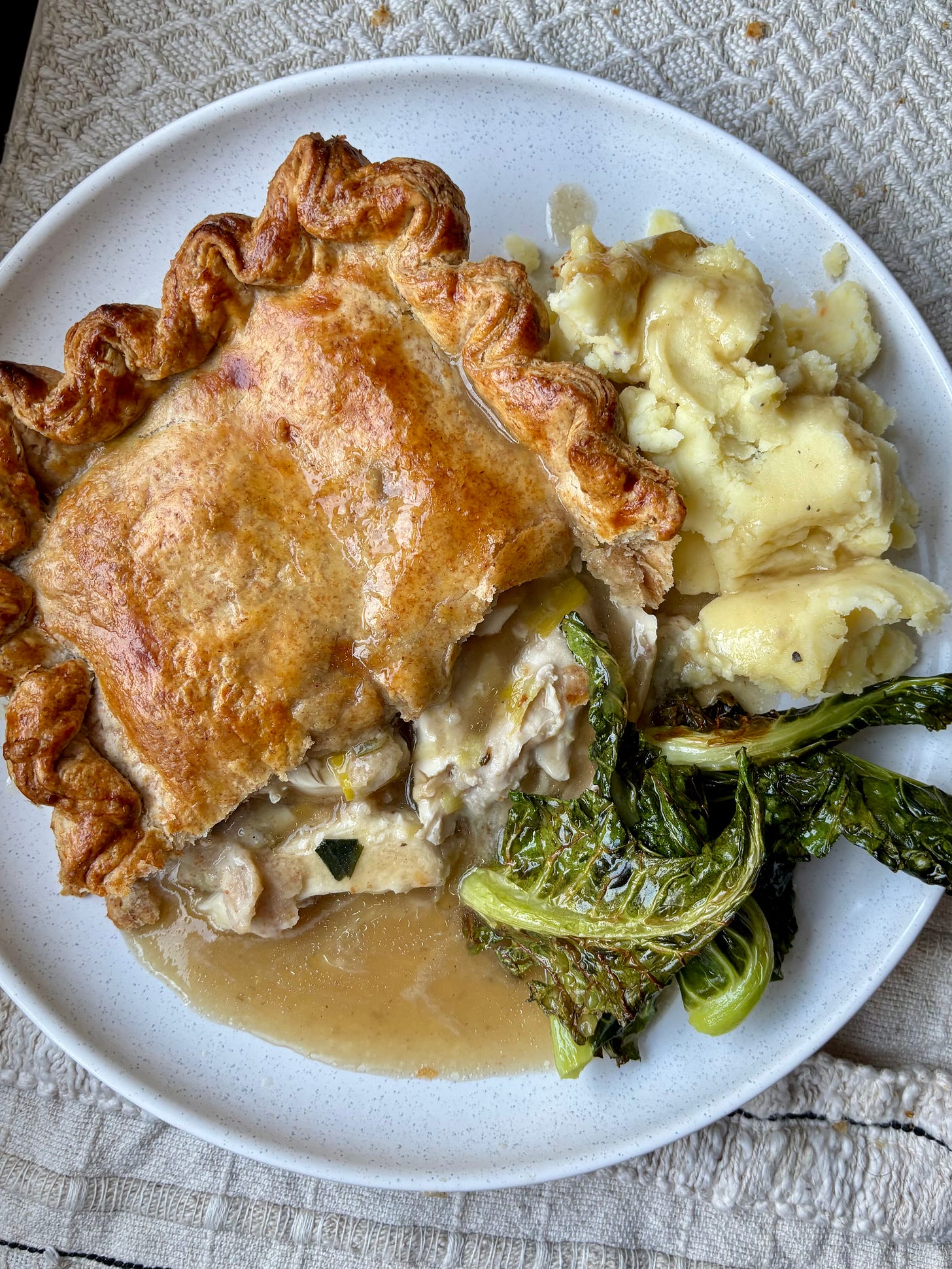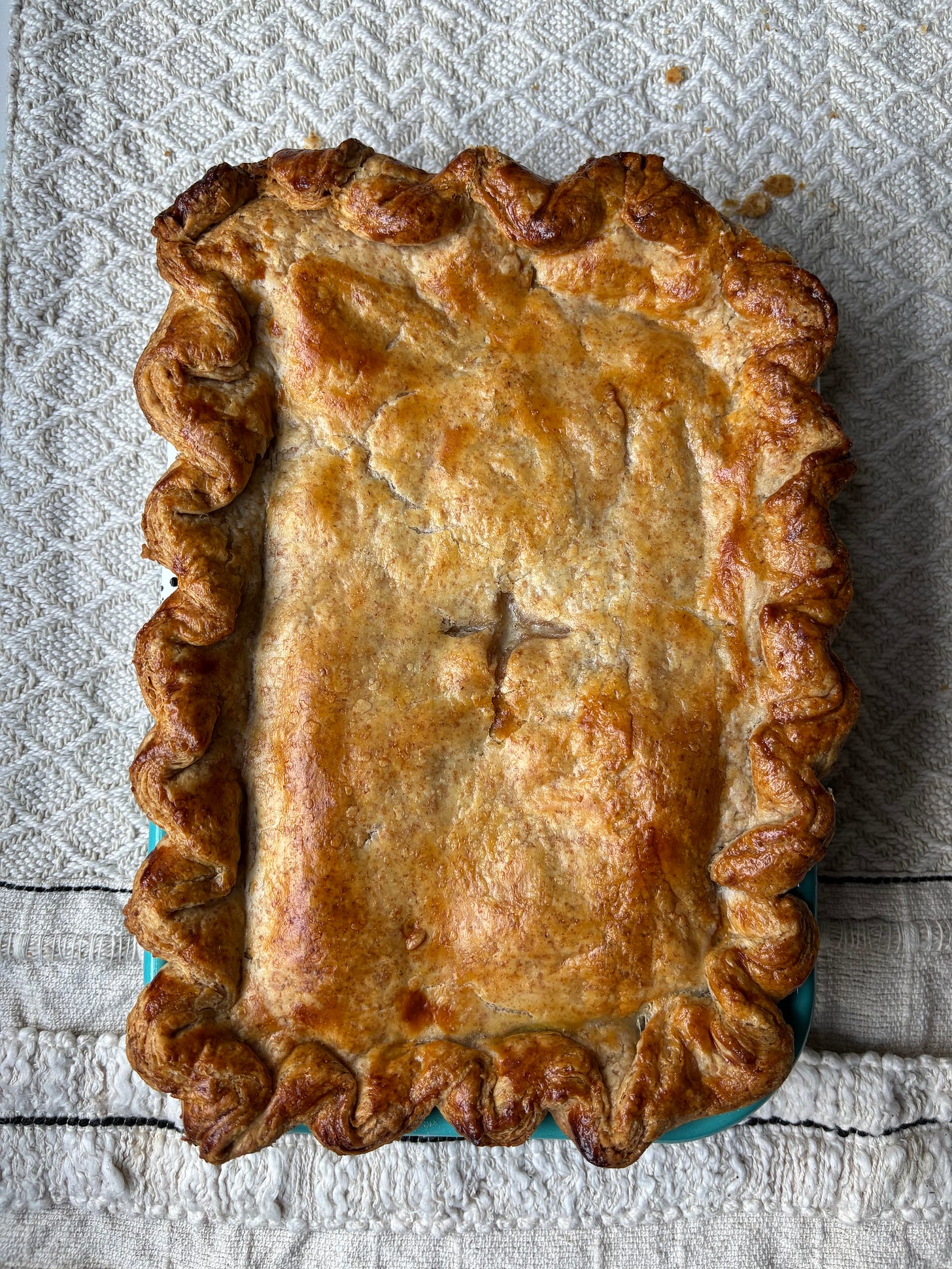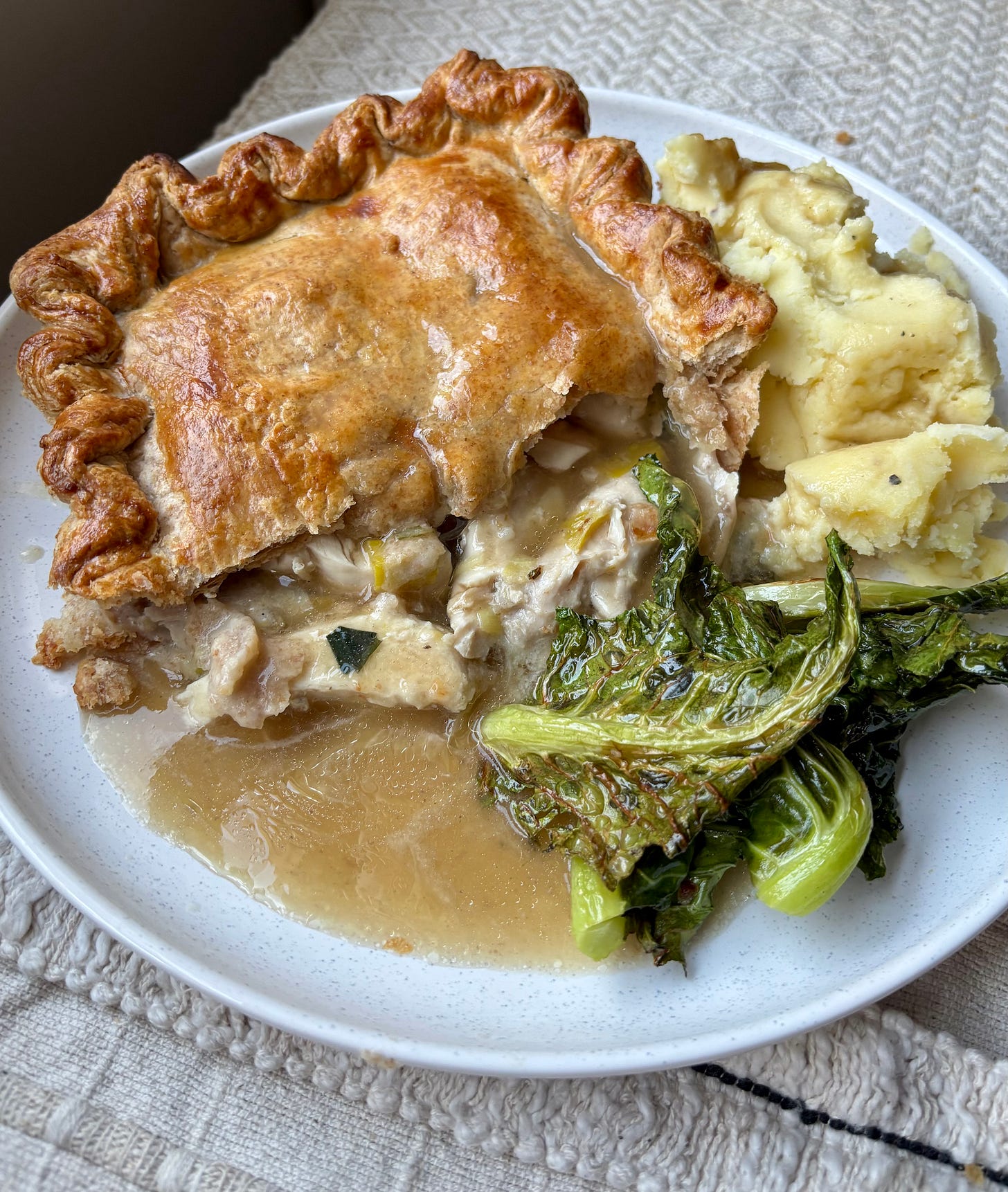Eco friendly restaurants often talk about how they use whole animals. Taking on a whole animal means you can trace its sourcing more easily, to know how it was produced, whether it’s actually free-range or organic or grown in a regenerative farming system, and you can ensure as much of it as possible is used. This principle is not as easy to take on at home, unless your butchery skills are top notch and you have a particularly large freezer. Cooking a whole chicken, however, is an option. We often buy packs of chicken breasts or chicken thighs without thinking about the animal they came from. Buying a whole bird is better value for money and means you can make the most of every piece.
A roast might seem like the obvious choice here, and they are great, but there are plenty of other ways to make the most of a chicken. Enter my spring chicken pie. For this recipe, I poach the chicken whole to cook it very gently, resulting in beautifully tender, juicy meat. The poaching liquid becomes stock during the cooking process so not only do you have the meat for the filling but you can use the flavour of the chicken imparted in the stock to create the sauce and gravy for your pie. After poaching, you strip the meat from the chicken carcass, ensuring all of it is used. Then the bones are roasted to draw out even more of their flavour to be used for the gravy. Because pie is always better when you serve it with extra gravy.
This method does take a bit of time but it’s a relatively simple process. You can leave the chicken bubbling away while you get on with other things. I’d recommend brining the chicken before you start, by sprinkling it with salt and leaving it to sit uncovered for a while helps lock in moisture, as well as seasoning it. It’s not imperative to do this step so don’t worry if you forget, but it is handy.
I’ve included instructions for making your own flaky pastry but you can use bought pastry if you prefer. Flaky is a little more involved than shortcrust as you layer in pieces of butter and lard to create shards of pastry. But you have plenty of time while the chicken cooks and the result is worth the extra effort. Another benefit of making your own is choosing the flour you use. I use a mixture of organic white and brown flour to give the pastry a more complex, nutty taste.
The fat layers in the pastry are a combination of butter and lard – the butter is there for flavour while the lard gives texture. They’re a great duo together but you can just use butter if that’s what you have. It’s important to assemble the pie while the filling is cool and the pastry is cold to keep the buttery, flaky texture intact. This makes the pie ideal for making in a batch. I split the mixture into two pies that serve four. One to eat later on the day of making, and one to go in the freezer where it’ll keep for up to three months.
We’re in peak spring right now so wild garlic season is in full swing. I’ve stirred shredded wild garlic leaves into the pie filling for that bright garlic flavour, that pairs beautifully with chicken and leeks.
Chicken, wild garlic and leek pie
Serves 8 (one very large or two medium pies)
2kg whole chicken
2 bay leaves
4 garlic cloves (unpeeled), bashed
1 onion or 2 shallots (unpeeled), halved
1 carrot, cut into chunks
1 tsp black peppercorns
Veg peels, scraps or stalks
30g salted butter
1 tsp olive oil
1 tsp caraway seeds
4 leeks, cut into 2cm thick slices
50g plain flour
180ml dry white wine or cider
200g crème fraîche
2 tsp Dijon mustard
100g wild garlic, leaves shredded
FLAKY PASTRY
200g plain flour, plus extra to dust
200g plain wholemeal flour, plus extra to dust
130g unsalted butter, cut into small chunks
130g lard, cut into small chunks (or more butter)
1 egg, beaten
GRAVY
20g salted butter
40g plain flour
100ml dry white wine or cider
1 tsp Dijon mustard
1 Up to one hour before you plan to start cooking, remove the bird from the fridge, unwrap and season all over with salt, including inside the cavity, then leave at room temperature. This will season the bird and dry brine it to lock in moisture.
2 Put the chicken in a large pan or stock pot, add the bay, garlic, onion, carrot, peppercorns and any veg peels, scraps or stalks you have (including the wild garlic stems) then cover with cold water. Bring to the boil then simmer very gently for 45-50 minutes until the chicken is cooked through.
3 While the chicken poaches, make the pastry. Put the flours in a bowl with a pinch of salt (you can also do this step in a food processor). Add half of the butter and lard, rubbing them in with your fingertips to create a breadcrumb-like texture. Add two-thirds of the beaten egg (saving the rest for egg washing) plus 5-7 tbsp ice-cold water, a little at a time, until you can bring the mixture together as a dough (you may not need all the water as it depends on your flour, so go slowly).
4 On a lightly floured work surface, roll the dough out into a large rectangle (about 45cm x 25cm), with one of the short ends closest to you. Dot one third of the remaining butter and lard over the bottom two thirds of the pastry. Fold the top third of the pastry over the top to cover half the butter/lard pieces, then fold the bottom third up to make a neat rectangle with all the butter/lard enclosed. Seal the edges, pressing down with a rolling pin. Wrap the pastry with baking paper or a beeswax wrap and pop in the fridge to chill for 10 minutes.
5 Unwrap the pastry, and put it on the work surface, turned 90 degrees from how it sat at the end of your first rolls and folds (so one of the sides should now be facing you). Repeat the rolling out, dotting with lard and butter, folding, sealing, wrapping and chilling for 10 minutes, two more times to use up all the remaining butter and lard. Then repeat once more but without adding any fat then wrap and keep chilled until you’re ready to assemble the pie.
6 Lift the cooked chicken out of the stock, draining as much of the liquid as possible back into the pot, and set aside on a plate to cool a little. Return the stock to the heat and simmer until reduced to 1.5 litres – this will intensify the flavour. Once the chicken has cooled enough for you to handle it, remove all of the meat from the bones, making sure you get all of the scraps from every nook and cranny of the carcass. Put the meat in a bowl, tearing the larger pieces into bite sized chunks. Keep all of the bones, skin and sinew in a roasting tin.
7 For the pie filling, heat the butter and oil in a large pan over a medium heat. Add the caraway seeds and cook for about a minute until sizzling and fragrant. Add the leeks with a pinch of salt, cover with a lid and cook for about 10 minutes, gently stirring every now and then, until softened but still holding their shape. Remove the lid and stir in the flour. Cook for a few minutes until slightly toasted and smelling biscuity. Increase the heat to medium-high, pour in the wine and bubble to make a sticky coating on the leeks.
8 Measure out 800ml of the chicken stock, then add this to the leeks, a little at a time, stirring with each addition to ensure there’s no lumps. Once it’s all added, stir in the crème fraîche, mustard and wild garlic. Remove from the heat and season to taste with plenty of flaky salt and freshly cracked black pepper. Leave to cool completely.
9 Once the pie filling is cool, divide the pastry into two pieces: one third and two thirds of the dough. Roll out the smaller piece on a lightly floured work surface for the pastry lid so 3cm bigger than the top surface area of your pie dish/es and set aside on a tray. Roll the larger piece out until 3cm bigger than your pie dish. Use it to line the dish with the pastry overhanging. Scrape the pie filling into the dish and spread evenly. Brush the edges of the pastry with a little beaten egg and lay the pastry lid on top. Crimp the edges by pinching together and pulling it up and over the top of the pie. Chill the assembled pie for 30 minutes.
10 Heat the oven to 180°C fan. Bake the pie for 40-45 minutes until golden and crisp. Meanwhile, roast the chicken carcass and bones in a roasting tin for about 25 minutes until golden. Remove from the oven and put the pan over a medium heat. Add the butter and stir to melt then stir in the flour. Cook for a few minutes until toasted then pour in the wine and mustard. Bubble until all combined then add the remaining 800ml stock, a little at a time, stirring with each addition to ensure there’s no lumps. Simmer the gravy gently for 5-10 minutes until thickened to your desired consistency. Keep warm over a low heat with a lid on until the pie is ready.
11 Serve the pie with mashed potatoes, greens and the gravy.
TIPS
This recipe makes enough for two pies to serve four people. I made one to serve four in a 18cm x 25cm pie tin, and then used the rest to make a two person pie and two individual pies for freezing.
Save your vegetable peels, tops and tails in a bag in the freezer ready to make stock or use in poaching liquids like with this recipe. You can add them straight from frozen.
Mindful mentions
Wild Garlic // The of-the-moment ingredient is something you have to use pretty quickly after picking. The obvious thing is to make pesto or crush into a compound butter, both of which you can freeze easily. I’ve written a few wild garlic recipes over the past few years that I really recommend. These Wild Garlic and Cheddar Scones are quick and easy and a great way for the wild garlic flavour to shine. If you are foraging wild garlic, make sure you leave plenty behind. It’s amazing to be able to collect food from the environment but we need to respect nature and make sure we don’t upset the balance by taking it. For it to regrow each year, wild garlic can’t be stripped bare so be conscious of how much you take.







